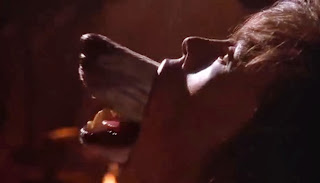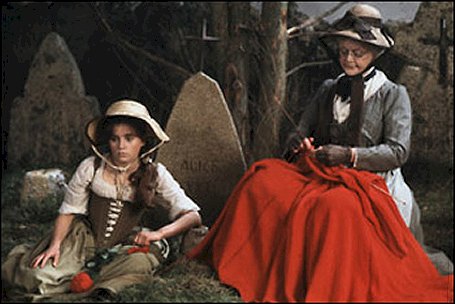The Company of Wolves is a film from 1984 from director Neil Jordan. If that name sounds strangely familiar, it may be because Jordan has brought two acclaimed vampire films to the Hollywood screen: Interview with the Vampire and Byzantium. Since Interview is one of my favorite vampire films, I couldn't help but be curious at how Jordan approached werewolves.
The first thing I will say about this film is that it is... odd. It is not really a linear storyline at all. The film's script is actually based on a short story collection by author Angela Carter, who also co-wrote the screenplay adaptation with Jordan. In order to connect these what-were-once-only-loosely-thematically-related tales, the film begins in contemporary England where two parents have returned home from a trip only to find that their youngest daughter has locked herself in her room. The mother is annoyed that her daughter is "sulking" and sends the eldest daughter to go fetch her sister from her room.
And that is just about the end of the modern storyline. As we enter the girl's bedroom, we are plunged into her dreams and the rest of the story is a semi-retelling of "Little Red Riding Hood" through the girl's dreamworld. It is a rather odd choice because, given that we know the whole story is a dream, very little seems to be at stake. Even with other fairytales where there is a frame story (like The Princess Bride), someone is typically telling the story so there is a sense of "reason" and known outcome. The fact that everything else in the film's story is a dream seems to cheapen the action somewhat right from the start.
The story now follows dream-versions of our previously introduced family. The eldest daughter in this world has been killed by a wolf-attack and now the family is in mourning. The younger daughter, our Little Red, stays with her grandmother after the funeral so that her parents have time to mourn. The grandmother is played by the ever amazing Angela Lansbury, who plays very much against type in this film as her character is cold, conservative, and fairly unlikable.
While the girl stays with her, Grandma Lansbury tells her horror tales about werewolves who attack girls who "stray from the path" - both literally the path in the woods (the way her sister did, causing her to be killed by a pack of wolves) or figuratively (straying from a moral path).
For most of the movie then, characters take turns telling stories about wolves. The grandmothers tales are all puritanical warnings about what "wolves" men can be and how they will turn into hideous monsters.
 |
| Like this... |
In rebellion, the girl imagines stories of her own. For example, one of her stories involves a pregnant peasant woman who uses the magic of her rage to turn the wealthy man who abandoned her (as well as all of his rich friends) into wolves who then must obey her forever.
Each story has a slightly different look from the "main" film and each has slightly different types of special effects. The wolf in the grandmother's first tale is an animatronic puppet, while the wolves in the girl's tale are real animals (mostly dogs with their fur painted; this film did not have much of a budget). The coloring and costuming is also fascinatingly different, with the grandmother's tales looking sooty and dark, and the girl's story actually looking a bit like the style and costuming Jordan would later use for Interview.
Each tale offers a different theory on what makes someone an "animal" and how women could either be active figures who control an animalistic power, or victims at the mercy of strange and wild animals.
The obviousness of the metaphor reminded me of Andy Warhol's Blood for Dracula, actually, and I'm not entirely sure that's a compliment. While there is nothing quite as obvious in this film as a hammer and sickle on someone's wall, the red cloak seems to be tied to Red's "becoming a woman" (blood red as a symbol for menstruation) and several lines in the film practically beat the audience over the head with the metaphor (Men are "animals. All wild animals.") As the movie progresses, there is also no question that all of the stories are about Little Red growing up and struggling with her own sense of sexuality, as well as how others see her as a sexual being.
 |
| And let's face it: given the look of this tree, Jordan is only slightly more subtle than Warhol |
After we are introduced to the different stories' theories, Little Red must then prove which theory is more "correct" when she meets a stylish but predatory man in the woods. From here, the plot almost follows the fairytale to the letter: the wolf-man gets to her grandmother's house, kills the grandmother, and then lays in wait to "eat" Little Red Riding Hood.
The wolf-man (posing as a huntsman) is played by Micha Bergese, who also plays a memorable role as the trickster Paris vampire in Jordan's later Interview with the Vampire. His wolf in this film is both threatening and charming, a believable predator. His performance is mostly fantastic, but it is marred slightly by an awkward script which literally includes the lines: "My, what big arms you have... All the better to hug you with."
 |
| That's all he wants: FREE HUGS! |
As the story comes to its climax, the audience expects Little Red to have to make a choice: will she become a victim the way her grandmother predicted or will she become a wielder of violent power and fight her attacker off? Surprisingly (unless you've read Carter's story), Red chooses neither option. Instead, she listens to the wolf and expresses empathy and understanding for him. She engages with him rather than seeing him as an enemy. As a metaphor it is beautiful... in the context of the plot, I did think she dismissed a bit quickly the fact that the wolf killed her grandmother. Yes, I know that too is metaphorical (killing off the old puritan ways) but it didn't seem very realistic.
Ultimately, it is that lack of any type of realism that holds this film back. When a good portion of the film is stories told within the context of a girl's dream, it is very difficult to be invested in what "happens." None of it is real or realistic, so why does the outcome matter in anyway other than as an extended metaphor?
On the other hand, the movie is beautifully shot, has lovely a mix of tones, some great performances, and a really unique look at female sexuality (and empathy) through the lens of a familiar fairytale. Even through the symbolism does feel a bit heavy-handed at times, Jordan and Carter did make something beautiful and unique. It may not be my favorite werewolf movie, or my favorite supernatural-themed film from Jordan, but it is a work of woman-centric art that I am glad I had a chance to see.
Rating: 3 out of 5 bites




No comments:
Post a Comment